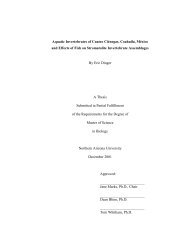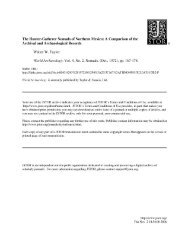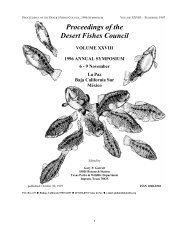Proceedings of the Desert Fishes Council 2000
Proceedings of the Desert Fishes Council 2000
Proceedings of the Desert Fishes Council 2000
You also want an ePaper? Increase the reach of your titles
YUMPU automatically turns print PDFs into web optimized ePapers that Google loves.
PROCEEDINGS OF THE DESERT FISHES COUNCIL - VOLUME XXX1I (<strong>2000</strong> SYMPOSIUM) – PUBLISHED NOVEMBER 13, 2001<br />
ABSTRACTS IN ORDER PRESENTED / RESUMENES EN ORDEN DE PRESENTACIÓN<br />
Abate, PD; Holden, PB; Ruppert, JB<br />
(BIO/WEST Inc., Logan UT)<br />
Razorback sucker studies on Lake Mead, Nevada and Arizona, 1999-<strong>2000</strong><br />
ABSTRACT<br />
Over <strong>the</strong> previous three years (1996-1999) razorback sucker studies on Lake Mead have followed two<br />
separate reproducing populations (at Echo Bay and Las Vegas Bay) and have documented exceptional growth<br />
rates <strong>of</strong> individual fish as well as limited recruitment. After <strong>the</strong> initial two years <strong>of</strong> data ga<strong>the</strong>ring, <strong>the</strong> study<br />
focus evolved to concentrate on determining when <strong>the</strong>se relatively young fish were recruited and whe<strong>the</strong>r o<strong>the</strong>r<br />
spawning populations were present in <strong>the</strong> lake. Lakewide larval sampling and aging <strong>of</strong> razorback sucker netting<br />
mortalities were conducted. Results indicated that, indeed, <strong>the</strong> Lake Mead population was relatively young,<br />
however no new spawning populations were located.<br />
Research activities for <strong>the</strong> 1999-<strong>2000</strong> study year continued with lakewide larval sampling, development and<br />
use <strong>of</strong> a non-lethal aging technique, and monitoring at <strong>the</strong> two populations centers where <strong>the</strong> study was initiated<br />
in 1996. Lakewide larval sampling located eleven larval razorback sucker at <strong>the</strong> Colorado River inflow area.<br />
Subsequent netting did not locate any spawners in this area. However, an adult razorback sucker was captured in<br />
this area by Arizona Game and Fish in 1998. Also during this study year, aging methods were refined and 11<br />
razorback sucker were aged. Select razorback suckers caught in trammel nets were anes<strong>the</strong>tized, and<br />
approximately quarter-inch segments <strong>of</strong> <strong>the</strong> second and third, left pectoral-fin rays were surgically removed.<br />
These segments were sectioned, sanded and polished, and read under a microscope. Of <strong>the</strong> 11 fish processed in<br />
this manner; four were aged at 13 years, three had an age range <strong>of</strong> 11-13 years and will be refined fur<strong>the</strong>r, and<br />
four <strong>of</strong> <strong>the</strong>m were 17 years or older with some refinement possible. Monitoring <strong>of</strong> razorback sucker at Echo Bay<br />
and Las Vegas Bay determined that <strong>the</strong>se populations varied <strong>the</strong>ir habitat use during fall/winter and<br />
spring/summer seasons as was evident in previous years. Also, both populations successfully produced larvae<br />
which were collected throughout <strong>the</strong> February through May <strong>2000</strong> spawning season.<br />
RESUMEN<br />
Estudios del matalote jorobado en el Lago Mead, Nevada y Arizona, 1999-<strong>2000</strong><br />
Durante los últimos tres años (1996-1999), en los estudios sobre el matalote jorobado [Xyrauchen texanus]<br />
en el Lago Mead, se han monotoreado dos poblaciones independientes de reproductores (en Bahía Echo y Bahía<br />
Las Vegas), registrando tasas individuales de crecimiento excepcional y poco reclutamiento. Después de los dos<br />
primeros años, el estudio se concentró en determinar cuándo es que estos peces relativamente jóvenes se<br />
reclutaron y si otras poblaciones de reproductores estaban presentes en el lago. Se tomaron muestras de larvas en<br />
todo el lago y se estimó la mortandad por edades de los matalotes capturados con redes. Los resultados muestran<br />
que, en efecto, la población del Lago Mead es relativamente joven; sin embargo, no fue localizada ninguna<br />
nueva población reproductora.<br />
Las investigaciones en 1999-<strong>2000</strong> continuaron con la toma de muestras de larvas en todo el lago, el<br />
desarrollo y uso de una técnica no letal para determinar edad y el monitoreo en la parte central de las dos<br />
poblaciones donde se inició el estudio en 1996. Se encontraron 11 larvas del matalote jorobado en el área de<br />
entrada del Río Colorado; en muestras tomadas posteriormente con redes no se hallaron reproductores en ese<br />
área. No obstante, personal del Departamento de Caza y Pesca de Arizona capturó allí a un adulto de esa especie<br />
en 1998. En este año de estudio también se refinó el método para edad y se determinó la edad de 11<br />
especimenes. Algunos peces capturados con redes tipo “trammel” fueron anestesiados y se les removieron por<br />
cirugía segmentos de casi ¼ de pulgada (63.5 mm) del segundo y tercero radio de la aleta pectoral izquierda.<br />
Estos segmentos fueron seccionados, lijados y pulidos, y analizados al microscopio. De los 11 peces estudiados,<br />
cuatro eran de 13 años, tres estuvieron en el intervalo de edad de 11 a 13 años (lo que se confirmará<br />
1



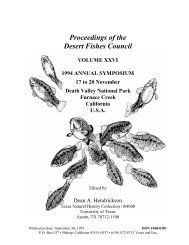
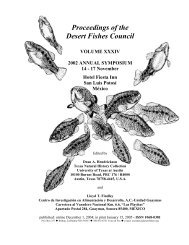
![Part 2 [419KK] - Desert Fishes Council](https://img.yumpu.com/14712282/1/190x245/part-2-419kk-desert-fishes-council.jpg?quality=85)

